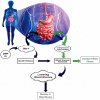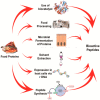The Role of Bioactive Peptides in Diabetes and Obesity
- PMID: 34574330
- PMCID: PMC8469013
- DOI: 10.3390/foods10092220
The Role of Bioactive Peptides in Diabetes and Obesity
Abstract
Bioactive peptides are present in most soy products and eggs and have essential protective functions. Infection is a core feature of innate immunity that affects blood pressure and the glucose level, and ageing can be delayed by killing senescent cells. Food also encrypts bioactive peptides and protein sequences produced through proteolysis or food processing. Unique food protein fragments can improve human health and avoid metabolic diseases, inflammation, hypertension, obesity, and diabetes mellitus. This review focuses on drug targets and fundamental mechanisms of bioactive peptides on metabolic syndromes, namely obesity and type 2 diabetes, to provide new ideas and knowledge on the ability of bioactive peptide to control metabolic syndromes.
Keywords: anti-inflammatory; antimicrobial; antioxidant; antiviral; bioactive peptides; diabetes; obesity.
Conflict of interest statement
The authors declare no competing financial interests.
Figures










References
-
- Abdel-Hamid M., Otte J., De Gobba C., Osman A., Hamad E. Angiotensin I-converting enzyme inhibitory activity and antioxidant capacity of bioactive peptides derived from enzymatic hydrolysis of buffalo milk proteins. Int. Dairy J. 2017;66:91–98. doi: 10.1016/j.idairyj.2016.11.006. - DOI
-
- Basilicata M.G., Pepe G., Adesso S., Ostacolo C., Sala M., Sommella E., Scala M.C., Messore A., Marzocco S., Campiglia P. Antioxidant properties of buffalo-milk dairy products: A β-Lg peptide released after gastrointestinal digestion of buffalo ricotta cheese reduces oxidative stress in intestinal epithelial cells. Int. J. Mol. Sci. 2018;19:1955. doi: 10.3390/ijms19071955. - DOI - PMC - PubMed
-
- Anadón A., Martínez M., Ares I., Ramos E., Martínez-Larrañaga M., Contreras M., Ramos M., Recio I. Acute and repeated dose (4 weeks) oral toxicity studies of two antihypertensive peptides, RYLGY and AYFYPEL, that correspond to fragments (90–94) and (143–149) from αs1-casein. Food Chem. Toxicol. 2010;48:1836–1845. doi: 10.1016/j.fct.2010.04.016. - DOI - PubMed
Publication types
Grants and funding
- 2018007551/National Research Foundation of Korea
- 4299990913942/Brain Korea (B.K.) 21 Plus Project
- GDOU2017052603/Enhancing School with Innovation of Guangdong Ocean University
- 2019KCXTD011/Guangdong Innovation and Research Team of Seafood Green Processing Technology
- R20048/Scientific Research Start-Up Funds of Guangdong Ocean University
LinkOut - more resources
Full Text Sources

